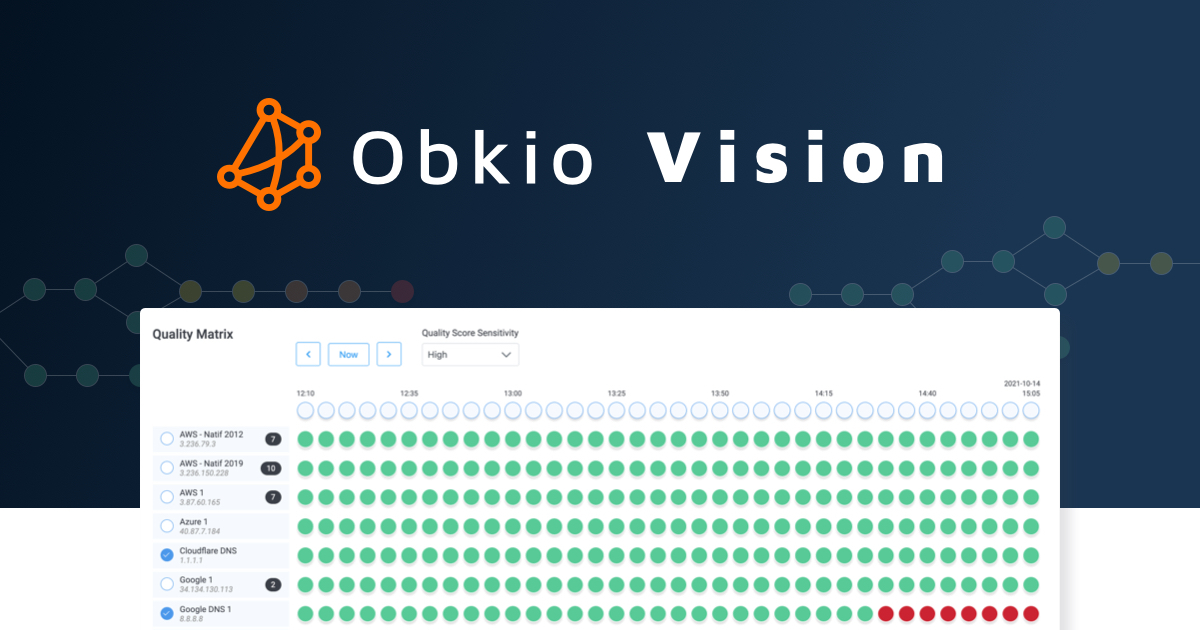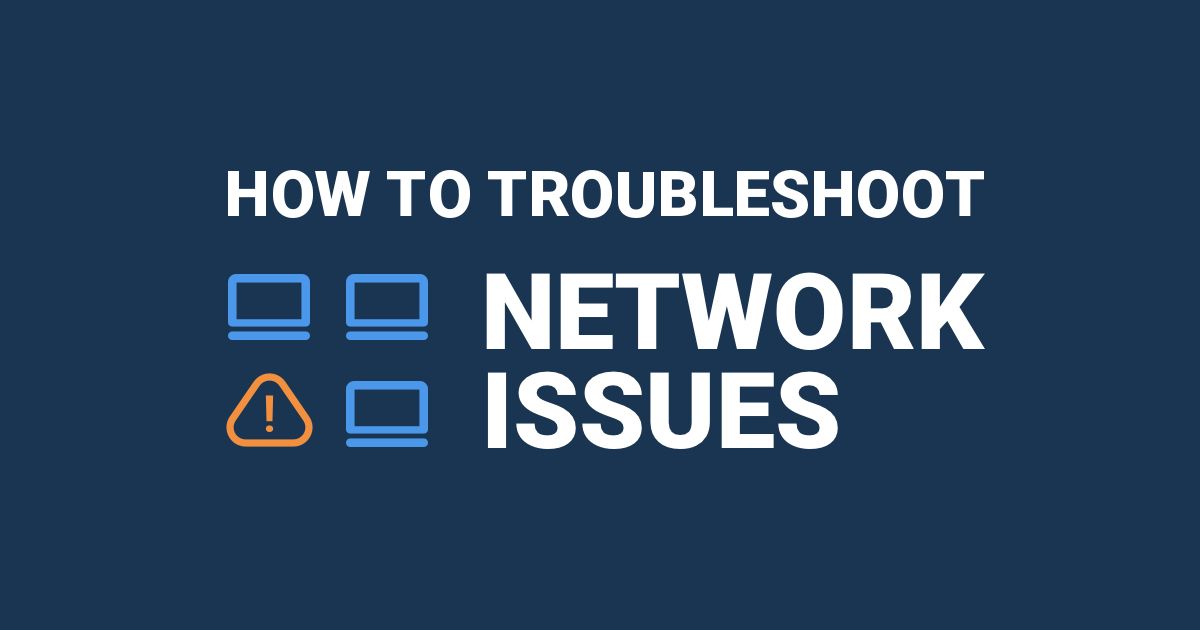Table of Contents
Table of Contents
Whether you're a seasoned network administrator or a curious tech enthusiast, the ability to diagnose and resolve network issues is an essential skill. When it comes to troubleshooting network problems, few tools are as powerful and revealing as the humble traceroute.
In this blog post, we'll delve into the world of traceroute troubleshooting, uncovering its inner workings and demonstrating how it can be your secret weapon in identifying and resolving network issues. Whether you're dealing with slow-loading websites, intermittent connectivity problems, or mysterious latency spikes, understanding how to use traceroutes effectively can be the key to maintaining a stable and reliable network.
Join us as we embark on a journey through the fascinating realm of traceroutes, where we'll demystify this indispensable tool, explore real-world examples, and equip you with the knowledge to become a network diagnostic virtuoso. By the end of this post, you'll be well-prepared to trace your way to network nirvana and conquer those vexing connectivity conundrums.
We have written a series of articles about traceroutes, the most popular tool that network engineers use to troubleshoot network performance.
When it comes to troubleshooting network issues, it's essential to have a solid understanding of the fundamental tools at your disposal. In this chapter, we'll start by peeling back the layers of traceroute, exploring what it is, how it works, and the key differences between traceroute and ping, another common network diagnostic tool.
At its core, traceroute is a network diagnostic tool that allows you to trace the path that data packets take from your local device to a remote server or destination. It provides a detailed list of all the intermediate network devices (routers) that the packets traverse, showing the time it takes to reach each one. This information is invaluable for pinpointing network issues, such as routing problems, bottlenecks, or unexpected delays.
Traceroute is a command-line utility available on various operating systems, including Windows, macOS, and Linux. It's relatively easy to use and provides valuable insights into your network's topology.

Traceroute operates by sending a series of Internet Control Message Protocol (ICMP) or User Datagram Protocol (UDP) packets to the target server with varying time-to-live (TTL) values. Each packet's TTL starts at 1 and is incremented by 1 for each successive packet. As the packets traverse the network, routers along the path decrease the TTL value. When the TTL reaches zero, a router discards the packet and sends an ICMP "Time Exceeded" message back to the sender.
By analyzing the ICMP "Time Exceeded" messages and the round-trip times of the packets, traceroute constructs a map of the route taken by the packets. This map is then presented to the user as a list of hops, showing the IP addresses or domain names of the routers in the path.
While both traceroute and ping are network troubleshooting tools, they serve different purposes and provide distinct insights:
- Ping: Ping is used to test the reachability of a host (usually a server or a device) and measures the round-trip time for a packet to travel to the host and back. It's a simple tool that verifies if a destination is online and responsive. However, it doesn't reveal the path packets take to reach the destination.
- Traceroute: Traceroute, on the other hand, focuses on revealing the intermediate hops between your device and the target server. It helps diagnose issues related to routing, congestion, and network performance. Traceroute is ideal for identifying the specific points where network problems may be occurring.
In summary, while ping is excellent for basic connectivity testing, traceroute is the go-to tool when you need to dig deeper into the network's infrastructure to diagnose and troubleshoot complex issues.
In the following chapters, we'll explore how to interpret traceroute results, use it effectively on various operating systems, and leverage it to resolve real-world network problems.
Learn about what a traceroute is, how traceroutes work, how to read a traceroute, and how they help network engineers troubleshoot network issues.
Learn more

Ready to Simplify Network Troubleshooting? Try Obkio's Network Monitoring Tool with Visual Traceroute Troubleshooting!
Are you tired of spending endless hours diagnosing network issues, only to be left with more questions than answers? It's time to take control of your network's performance and make troubleshooting a breeze. Obkio's Network Monitoring tool, complete with the powerful Visual Traceroute feature, is your solution for fast, easy, and comprehensive network troubleshooting.

Why Choose Obkio?
- Visual Traceroute: Our Visual Traceroute feature provides a clear, interactive map of your network's path, allowing you to pinpoint issues with precision. Say goodbye to cryptic terminal commands and hello to a user-friendly interface that simplifies the troubleshooting process.
- Real-Time Monitoring: With Obkio, you'll have access to real-time data on your network's performance. Identify bottlenecks, routing problems, and latency issues as they happen, ensuring a seamless user experience.
- Cross-Platform Compatibility: Obkio works across multiple operating systems, making it a versatile choice for your network monitoring needs.
- 24/7 Support: Our dedicated support team is here to assist you at any time, helping you resolve issues promptly and efficiently.
Are you ready to revolutionize your network troubleshooting experience? Try Obkio's Network Monitoring tool and experience the power of Visual Traceroute for yourself. Say goodbye to network mysteries and hello to a more efficient, reliable, and responsive network.

Traceroute is a powerful tool, but to harness its full potential, you need to understand how to interpret its results. In this chapter, we will delve into the art of analyzing traceroute output, explore the significance of Time-to-Live (TTL) and hops, and demystify the roles of IP addresses and domain names in the traceroute journey.
Interpreting traceroute output may seem daunting at first, but it's a valuable skill for network troubleshooting. When you run a traceroute, the output typically presents a list of hops, each with corresponding IP addresses or domain names, and the time it took for the packet to reach that hop. Here's how to analyze the key components of traceroute output:
Hop Number: Each line in the traceroute output represents a hop on the path from your local device to the target server. The hop number indicates the sequence in which that router or device was encountered.
IP Address or Domain Name: Traceroute provides information about the intermediate devices along the route in two formats: IP addresses and domain names. These identifiers help you identify the routers and systems involved in data transmission.
Round-Trip Time (RTT): The time taken for a packet to travel from your device to a particular hop is recorded as the Round-Trip Time. It helps you gauge the latency and performance at each stage of the journey.
 From Obkio Vision: Visual Traceroute tool
From Obkio Vision: Visual Traceroute tool
Understanding TTL is crucial to comprehending how traceroute works. TTL is a value assigned to each packet, and it decreases by one each time the packet passes through a router. When the TTL reaches zero, the router discards the packet and sends an ICMP "Time Exceeded" message back to your device. This behavior is the basis for constructing the traceroute results. Key points to remember:
Hops: The hop number indicates the number of times the packet was allowed to pass through a router. It's a fundamental concept that helps you track the journey from your device to the destination.
TTL Expiry: When the TTL of a packet expires, it provides the basis for identifying the routers in the path. Traceroute leverages this mechanism to uncover the sequence of routers, as each one decrements the TTL on its journey.
Traceroute output displays both IP addresses and domain names for the intermediate devices in the path. Here's what you need to know about these identifiers:
IP Addresses: IP addresses are numerical representations of network devices. They are essential for precisely identifying routers and servers, making it easier to locate and troubleshoot issues.
Domain Names: Domain names, such as www.example.com, are more user-friendly labels for devices on the internet. Traceroute may provide domain names if reverse DNS (Domain Name System) lookups are enabled. Domain names offer a more human-readable view of the route.
In the subsequent chapters, we'll use these concepts to diagnose common network issues and explore practical traceroute troubleshooting techniques. With a solid grasp of interpreting traceroute results, you'll be well-prepared to navigate the complexities of network troubleshooting.
When looking at a traceroute, we usually have two important values for each hop or router: latency and packet loss. These values provide crucial insights into the health and performance of your network.
Let’s take a look at this traceroute from the Obkio Live Traceroute feature:
+---+-------------------+-------+-----+------+------+------+------+
| # | Hostname | Loss% | Snt | Last | Avg | Best | Wrst |
+---+-------------------+-------+-----+------+------+------+------+
| 1 | 192.168.1.1 | 0.0 | 10 | 1.0 | 1.6 | 0.5 | 3.9 |
| 2 | router1.ispA.com | 10.0 | 10 | 5.0 | 5.6 | 4.5 | 7.9 |
| 3 | router2.ispB.com | 0.0 | 10 | 10.0 | 10.6 | 9.5 | 15.9 |
| 4 | router3.ispC.com | 0.0 | 10 | 12.0 | 12.6 | 11.5 | 22.9 |
| 5 | router4.ispC.com | 0.0 | 10 | 13.0 | 13.6 | 12.5 | 23.9 |
| 6 | router5.ispC.com | 0.0 | 10 | 14.0 | 14.6 | 13.5 | 21.9 |
| 7 | router6.ispC.com | 0.0 | 10 | 15.0 | 15.6 | 14.5 | 29.9 |
| 8 | website.com | 0.0 | 10 | 16.0 | 16.6 | 15.5 | 39.9 |
+---+-------------------+-------+-----+------+------+------+------+
Figure A
Latency, often referred to as Round-Trip Time (RTT), is a key metric in traceroute results. It represents the time it takes for a packet to travel from your device to a particular hop (router or device) and back. Understanding latency is vital for assessing the responsiveness and speed of your network. Here are some key points about latency in a traceroute:
- Measuring Delays: Latency is measured in milliseconds (ms) and is the primary indicator of the delay experienced by data packets. Lower latency values indicate faster responses, while higher values suggest slower network performance.
- Identifying Bottlenecks: High latency at a specific hop can be a sign of congestion, hardware issues, or network problems at that point in the route. By analyzing latency values, you can pinpoint potential trouble spots.
- Interpreting Variability: Consistency matters. Fluctuations in latency can impact the user experience. Traceroute helps you detect variations in latency, allowing you to identify intermittent issues.
Packet loss is another crucial metric, and it signifies the percentage of data packets that fail to reach their intended destination. Packet loss can severely degrade network performance and lead to issues such as dropped calls or interrupted video streams. Here's what you need to know about packet loss:
- Measuring Packet Loss: Packet loss is expressed as a percentage. A high packet loss rate indicates a problematic hop, where data packets are being lost along the way.
- Troubleshooting Quality Issues: Packet loss is a strong indicator of network quality problems. It may result from network congestion, misconfigured routers, or faulty hardware.
- Correlating with Latency: High packet loss often accompanies increased latency, as retransmissions of lost packets can cause delays. Traceroute helps you establish a relationship between latency and packet loss to identify the source of network issues.
By examining these two critical values in a traceroute, you can quickly assess the network's overall health and pinpoint trouble areas. The combination of latency and packet loss data empowers you to troubleshoot and address network problems efficiently. In the next sections, we'll explore how to use this knowledge to diagnose common network issues and maintain a reliable and responsive network environment.
In the example provided earlier, a packet loss rate of 10% at hop 2 may initially seem like a significant issue. However, the significance of this loss becomes clearer when we examine the number of packets sent (Snt column). In this case, 1 packet was lost out of the 10 that were sent, resulting in a 10% packet loss rate.
It's important to remember that the impact of packet loss varies depending on the number of packets involved. In this example, losing one packet out of ten might not have a noticeable effect on user experience. However, if we were dealing with a much larger volume of data, such as 1,000 or 10,000 packets, that 10% loss rate would indeed become a more serious concern.
Many traceroute tools offer configuration options that allow you to adjust the number of packets sent and the intervals at which they are sent. This flexibility is particularly useful when dealing with larger networks or when you need to gather more data to assess the extent of packet loss accurately.
For effective troubleshooting, it's essential to consider both the percentage of packet loss and the total number of packets sent. By taking these factors into account, you can make informed decisions about the severity of network issues and take appropriate actions to improve network performance and reliability. In the subsequent sections, we'll delve into practical troubleshooting techniques and demonstrate how to use these insights to diagnose and resolve network problems effectively.
How to measure packet loss with Obkio’s Network & Packet Loss Monitoring tool. Check for packet loss in your network & read packet loss measurements.
Learn more

Traceroute is a valuable tool for diagnosing a wide range of network problems. In this chapter, we will explore how to identify some of the most common network issues by examining their unique traceroute signatures. By understanding these signatures, you'll be better equipped to pinpoint and resolve network problems efficiently.
Packet loss is a prevalent issue that can disrupt the smooth flow of data in a network. Traceroute can help you identify packet loss by analyzing the following traceroute signatures:
- Consistent Loss at a Specific Hop: If you consistently observe packet loss at a particular hop, it may indicate issues with the router at that point. Traceroute allows you to pinpoint where in the network the loss is occurring.
- Increasing Loss Rates: Gradually increasing packet loss rates as you move further down the traceroute often point to congestion or network saturation. This can help you identify where network resources are being strained.
- Intermittent Loss: Intermittent packet loss can be challenging to diagnose but can be a sign of periodic network issues. Traceroute provides a history of packet loss, making it easier to identify recurring problems.
Latency and slow connections are significant concerns, especially for applications that require real-time data transmission. Traceroute signatures for latency issues include:
- Consistently High Latency at a Hop: If you notice consistently high latency values at a specific hop, it suggests a bottleneck or delay at that router. Traceroute helps you pinpoint the exact location of the problem.
- Latency Spikes: Traceroute can capture latency spikes, revealing moments when data packets experience unusually long delays. These spikes may indicate congestion, routing problems, or other issues that affect network performance.
- Variable Latency: Fluctuating latency values can make applications less responsive. Traceroute allows you to track variations in latency and identify hops where latency is inconsistent.
Routing loops and misconfigurations can lead to data being trapped or endlessly rerouted within a network. Traceroute provides valuable insights into these issues with the following signatures:
- Repeated Hops: A traceroute signature indicating a loop is when the same hop appears multiple times in the route. This suggests that data packets are traversing the same network segment repeatedly, causing delays and inefficiencies.
- Inconsistent or Non-Sequential Hops: In a correctly functioning network, traceroute should display a sequential progression of hops. When you observe inconsistencies or out-of-order hops, it's a potential indicator of routing misconfigurations.
- Sudden Path Changes: Abrupt changes in the traceroute path, especially when data packets start going in unexpected directions, may signify a routing misconfiguration or the presence of unintended paths.
By recognizing these traceroute signatures, you can effectively diagnose and troubleshoot common network issues. In the following chapters, we'll delve into practical traceroute troubleshooting techniques, allowing you to apply this knowledge to real-world scenarios and ensure the reliability of your network.


The rule of thumb when looking at a traceroute is very simple:
If the packet loss doesn't continue, don’t panic, it’s not an issue!
+---+-------------------+-------+-----+------+------+------+------+
| # | Hostname | Loss% | Snt | Last | Avg | Best | Wrst |
+---+-------------------+-------+-----+------+------+------+------+
| 1 | 192.168.1.1 | 0.0 | 10 | 1.0 | 1.6 | 0.5 | 3.9 |
| 2 | router1.ispA.com | 50.0 | 10 | 5.0 | 5.6 | 4.5 | 7.9 |
| 3 | router2.ispB.com | 0.0 | 10 | 10.0 | 10.6 | 9.5 | 15.9 |
| 4 | router3.ispC.com | 0.0 | 10 | 12.0 | 12.6 | 11.5 | 22.9 |
| 5 | router4.ispC.com | 0.0 | 10 | 13.0 | 13.6 | 12.5 | 23.9 |
| 6 | router5.ispC.com | 0.0 | 10 | 14.0 | 14.6 | 13.5 | 21.9 |
| 7 | router6.ispC.com | 0.0 | 10 | 15.0 | 15.6 | 14.5 | 29.9 |
| 8 | website.com | 0.0 | 10 | 16.0 | 16.6 | 15.5 | 39.9 |
+---+-------------------+-------+-----+------+------+------+------+
Figure B
Let’s take a look at Figure B. We all know that 50% packet loss over a connection is terrible and makes it almost unusable. So are there any issues with this new traceroute example? Let’s apply the rule of thumb and figure it out.
Does the 50% packet loss continue in the traceroute? Does every hop report that same 50% that we see with hop #2? The answer is no, otherwise we would see packet loss with hops #3 through #8.
Should we panic and call our ISP to tell them we have packet loss on the path? No! Does it mean there is an issue with that router? No! It only tells us that hop #2 is responding to 50% of the packet or that 50% of the “ICMP TTL Exceeded” message returns to the source.
A deep dive on why we have packet loss with that hop is covered in Why Do Some Routers Drop Packets or Have High Latencies?.
Find out why single routers can drop traceroute packets or have higher latencies and why that’s normal.
Learn more

Looking at the example above, is the latency good? Is it normal? With only this traceroute and no more information, we don’t know.
The latency between two hops can be affected by a number of things such as:
- the distance between them
- the medium connecting them (fiber optic, coax cable, copper lines, wireless, etc.)
- the technology used (cable Docsis, DSL, GPON, dedicated fiber, etc.)
- the configuration on the routers such as traffic shaping
- the network condition such as congestion
So to be able to qualify the latency in a traceroute as good or bad, we need to know more information about the path. That information can come from our experience or knowledge of the path and routers, but the best one comes from historical traceroutes.
By comparing the latency over time, it’s much easier to know if the latency we are looking at is normal or not. Of course, a network performance monitoring solution such as Obkio has historical traceroute features that can help with that.
Learn how to measure latency with Obkio’s Network & Latency Monitoring tool. Check for latency in your network & analyze latency measurements.
Learn more

Here is another example similar to Figure B. We have the same path from the source to the destination but the packet loss and the latency values are different.
+---+-------------------+-------+-----+------+------+------+------+
| # | Hostname | Loss% | Snt | Last | Avg | Best | Wrst |
+---+-------------------+-------+-----+------+------+------+------+
| 1 | 192.168.1.1 | 0.0 | 10 | 1.0 | 1.6 | 0.5 | 3.9 |
| 2 | router1.ispA.com | 50.0 | 10 | 50.0 | 55.6 | 33.5 | 77.9 |
| 3 | router2.ispB.com | 50.0 | 10 | 52.0 | 54.6 | 9.5 | 56.9 |
| 4 | router3.ispC.com | 50.0 | 10 | 54.0 | 53.6 | 32.5 | 66.9 |
| 5 | router4.ispC.com | 50.0 | 10 | 55.0 | 55.6 | 44.5 | 72.9 |
| 6 | router5.ispC.com | 50.0 | 10 | 53.0 | 52.6 | 21.5 | 58.9 |
| 7 | router6.ispC.com | 50.0 | 10 | 52.0 | 56.6 | 29.5 | 99.9 |
| 8 | website.com | 50.0 | 10 | 56.0 | 55.6 | 43.5 | 87.9 |
+---+-------------------+-------+-----+------+------+------+------+
Figure C
Step 1: Checking Packet Loss
Let’s start with checking packet loss and the rule of thumb: does the packet loss continue after it started? Oh yes! In this case, we see 50% packet loss increase between hop #1 and hop #2 and it continues all the way to the last hop. So in this case, there are chances that there is indeed some packet loss between hop #1 and #2.
Step 2: Checking the Reverse Path
Be careful, Internet traffic is asymmetrical so the issue can be on the reverse path! This topic is covered in Internet Traffic is Asymmetrical - How to Catch Reverse Path Issues?.
So if there is packet loss with routers at ISP A, ISP B and ISP C, maybe we should call all of them and tell them they have 50% packet loss on their routers… or maybe post that on social media... or maybe not… We should focus on where the packet loss starts and where it is between hop #1 and hop #2.
Step 3: Checking Latency
Let’s take a look at the other network performance metric we have in this traceroute, the latency. By comparing Figure B and C, it’s clear that there is an increase in the latency values, and it all starts between hop #1 and #2, just like the packet loss.
In this case, with an increase of packet loss and an increase of latency, it looks like network congestion.
Step 4: Analyzing Network Congestion
Since Hop #1 (192.168.1.1) is the business’ firewall and Hop #2 (router1.ispA.com) is the ISP A router, the congestion is probably on the business Internet connection. By looking at the bandwidth usage on the firewall, the IT administrator of the business can easily validate if there is congestion. A solution such as Obkio’s Network Device Monitoring solution is able to get that info.
In the case where there is no congestion, a trouble ticket can be opened with ISP A to troubleshoot the network issues and the traceroute must be shared with them to accelerate the troubleshooting.
Leverage Obkio Vision to monitor, detect and troubleshoot network problems with visual traceroutes, IP route historic and graphical network maps.
Try for Free

So now that we looked at some examples of troubleshooting wihth traceoutes, let's summarize what we learned and dive into the practical aspects of using traceroute as a troubleshooting tool. You'll learn how to read traceroute output like a pro and discover valuable tips for efficiently using this tool to diagnose and resolve network issues.
Interpreting traceroute output is a skill that can greatly enhance your ability to troubleshoot network problems. Here's how to read traceroute like a pro:
- Start at the Top: When analyzing traceroute output, begin at the top and work your way down. The first few hops are usually within your local network or your Internet Service Provider's network, and the later hops are closer to the target server.
- Focus on Latency and Packet Loss: Pay close attention to latency (Round-Trip Time) and packet loss values at each hop. A significant increase in latency or a high packet loss rate may indicate a problem.
- Look for Consistency: Consistent values in latency and packet loss are often a sign of stable network conditions. Variability or spikes can indicate network issues.
- Identify Hostnames: When possible, traceroute may provide domain names along with IP addresses for each hop. This can help you identify routers and servers more easily.
- Check for Reverse DNS Lookup: If you see domain names instead of IP addresses, it likely means reverse DNS lookup is enabled. This can be a helpful feature for tracking routers, but it can slow down the traceroute process.
- Examine the Number of Hops: Note the number of hops in the route. A longer route may indicate inefficient routing, while an abrupt change in the number of hops may suggest a network issue.
Efficiency is key when using traceroute for troubleshooting. Here are some tips to make your traceroute usage more productive:
- Adjust Packet Count: Traceroute tools often allow you to adjust the number of packets sent for each hop. Increasing the packet count can provide a more comprehensive view of packet loss and latency.
- Set Timeouts: Configure timeout values to control how long traceroute waits for a response from each hop. Shorter timeouts can speed up the process, while longer timeouts may provide more accurate results.
- Use Traceroute Variants: Consider using traceroute variants like MTR (My TraceRoute) or Paris Traceroute, which offer additional features and insights into network performance.
- Cross-Platform Compatibility: Familiarize yourself with the traceroute commands on various operating systems (Windows, macOS, Linux) to troubleshoot network problems on different devices.
- Document Results: Keep a record of traceroute results for reference and comparison. This documentation can be valuable when tracking changes in network behavior over time.
- Combine with Other Tools: Traceroute is most effective when used in conjunction with other network diagnostic tools like ping, pathping, and network monitoring tools. Combining these tools can provide a comprehensive view of network issues.
By following these tips and mastering the art of reading traceroute output, you can become a more efficient and effective network troubleshooter.


Before we leave you to start troubleshooting with traceroutes, let's end off by exploring best practices and guidelines for effective network troubleshooting using traceroute. You'll discover a structured network troubleshooting workflow and learn about safety precautions and ethical considerations when using traceroutes as part of your diagnostic process.
A systematic approach to network troubleshooting can save time and ensure you identify and resolve issues efficiently. Here's a network troubleshooting workflow that incorporates the use of traceroute:
Define the Problem: Start by clearly defining the network issue you're facing. Is it slow connectivity, packet loss, or an unreachable destination? Understand the symptoms and their impact on your network or applications.
Gather Information: Collect relevant information about your network, such as network diagrams, configurations, and historical data. This information will serve as a network baseline for comparison.
Run Traceroute: Initiate traceroute to the target destination and relevant intermediate hops. Pay close attention to latency and packet loss values at each hop, and look for unusual patterns.
Cross-Reference with Other Tools: Use additional diagnostic tools such as ping, pathping, or network analyzers to corroborate traceroute findings. This will help you establish a more complete picture of network behavior.
Isolate the Problem: Once you've identified potential issues, isolate them by ruling out unaffected network segments. Focus your efforts on the most likely source of the problem.
Implement Changes or Fixes: If the issue is related to your network's configuration, routing, or hardware, make the necessary changes or fixes. Ensure that you follow best practices and maintain documentation.
Test and Monitor: After implementing changes, perform further testing and monitor the network to confirm that the issue has been resolved. Continue to track network performance to identify any recurring problems.
Document the Solution: Maintain detailed records of the issue, the steps you took to resolve it, and the results of your troubleshooting. This documentation will be invaluable for future reference.
Educate and Share Knowledge: Share your findings and solutions with your team or community to promote knowledge sharing and prevent similar issues in the future.
Learn how to use Obkio Vision’s Visual Traceroute tool to troubleshoot network problems with traceroutes in your LAN, WAN, and everything in between.
Learn more

While traceroute is a powerful tool, its usage should be conducted with care and ethical considerations in mind:
- Respect Privacy: When using traceroute on public networks or the internet, respect privacy and data protection laws. Avoid running traceroute on networks or systems without permission.
- Avoid Overloading Networks: Running an excessive number of traceroutes or sending a high volume of packets can strain networks and disrupt services. Use traceroute judiciously, especially in shared or production environments.
- Understand Legal and Regulatory Considerations: Be aware of legal and regulatory requirements that may apply to your network or the networks you troubleshoot. Compliance with these rules is essential.
- Secure Access: Secure access to the systems from which you run traceroutes. Unauthorized access to network devices or systems can result in serious consequences.
- Protect Sensitive Information: Ensure that you don't inadvertently expose sensitive information during traceroute operations, such as IP addresses, device names, or network configurations.
By following these safety precautions and ethical guidelines, you can use traceroute responsibly and contribute to the efficient resolution of network issues while maintaining the integrity of network security and privacy.
Congrats! You now know the intricaies of traceroute troubleshooting, an essential skill for maintaining stable and reliable networks. Traceroute is a powerful tool that unveils the path that data packets take from your device to a remote server, shedding light on the key components of network performance. As we wrap up this journey through traceroute troubleshooting, let's reflect on the significance of this tool in modern networking.
- Diagnosing Network Problems: Traceroute is the go-to tool for identifying and resolving a myriad of network issues, from packet loss to high latency and routing problems. Its ability to trace the path of data packets allows network administrators to pinpoint trouble spots with precision.
- Ensuring Optimal Performance: Traceroute is an integral part of maintaining network performance. By using it to detect and address issues proactively, network professionals can ensure that their networks operate at peak efficiency, delivering a seamless experience to users.
- Enhancing User Experience: In an era where end-users demand fast and reliable access to applications and services, traceroute empowers network administrators to meet these expectations. By using this tool, they can troubleshoot and optimize network performance, resulting in a smoother user experience.
Empowering Yourself with Obkio NPM and Obkio's Visual Traceroute Tool
As you embark on your journey of mastering network troubleshooting, it's essential to equip yourself with the right tools. Obkio's Network Performance Monitoring (NPM) solution, coupled with the Visual Traceroute tool, offers an invaluable resource for network administrators and professionals.

With Obkio's NPM and Visual Traceroute, you gain access to real-time insights into your network's performance. The visual representation of traceroutes enhances your ability to identify issues with precision. Whether you're dealing with latency problems, packet loss, or routing inefficiencies, Obkio's tools provide a user-friendly interface and detailed data, simplifying the troubleshooting process.
Remember, network issues can impact your organization's bottom line and user satisfaction. By incorporating traceroute into your toolkit, backed by Obkio's NPM and Visual Traceroute tools, you're better prepared to tackle network challenges head-on, ensuring the stability, reliability, and optimal performance of your network.
In a world where networks are the lifeblood of our digital experiences, traceroute is your secret weapon in keeping those connections strong. Harness its power, and your network will thank you with seamless, uninterrupted service.

We hope you enjoyed this article on identifying network issues with traceroutes.
You can learn everything you need to know about traceroutes in our free complete guide to traceroutes!
Download Obkio's free Complete Guide to Traceroutes to learn to identify network problems with the most popular network troubleshooting tool for IT Pros.
Download Now

Or check out the next articles in the series:
- What is a Traceroute and How Do Traceroutes Work?
- How To Identify Network Issues with Traceroutes? (this article)
- Why Do Some Routers Drop Packets or Have High Latencies?
- Decode the Hidden Information from Traceroute DNS
- Internet Traffic is Asymmetrical - How to Catch Reverse Path Issues?
- How to Share a Traceroute With an ISP NOC?
- Impact of Load Balancing or Multiple Paths on Traceroutes
- MPLS Networks, TTL Propagation and ICMP Tunneling


























 Obkio Blog
Obkio Blog












